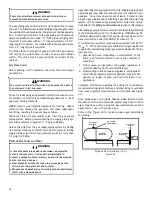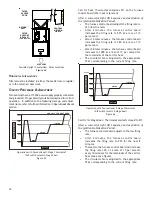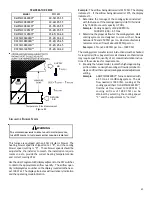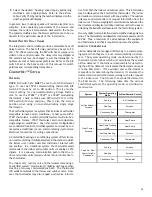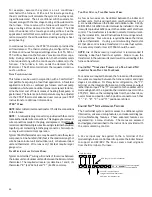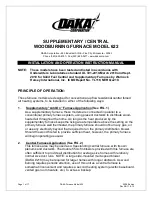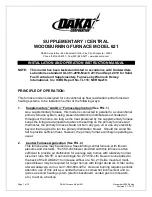
45
8. Select the desired “heating” speed tap by positioning
switches 3 and 4 appropriately. Refer to the airflow
table. Verify CFM by noting the number displayed on the
dual 7-segment LED display.
In general, lower heating speeds will reduce electrical con-
sumption, lower operating sound levels of the blower, and
increase the outlet air temperature delivered to the home.
The speeds available allow the blower performance to be op-
timized for the particular needs of the installation.
B
LOWER
H
EAT
O
FF
D
ELAY
T
IMINGS
The integrated control module provides a selectable heat off
delay function. The heat off delay period may be set to 90,
120, 150, 180 seconds using the DIP switches or jumper pro-
vided on the control module. The delay is factory shipped at
150 seconds but may be changed to suit the installation re-
quirements and/or homeowner preference. Refer to the DIP
switch chart in the back section of this manual for switch
positions and corresponding delay times.
C
OMFORT
N
ET
™ S
YSTEM
O
VERVIEW
NOTE:
DIP switch #13
MUST
be set to match thermostat
type. To use the CTK01 communicating thermostat, DIP
switch #13 must be set to ON position. This is also the
correct setting for a non-communicating 2-stage thermo-
stat. To use the CTK02**, CTK03** or CTK04** modulating
thermostat, check to make sure DIP switch #13 is in the
OFF position (factory position). This is also the correct
position when using a non-communicating single stage
thermostat.
The ComfortNet system is a system that includes a ComfortNet
compatible furnace and air conditioner or heat pump with a
CTK0* thermostat. A valid ComfortNet system could also be a
compatible furnace, CTK0* thermostat and non-compatible,
single stage air conditioner. Any other system configurations
are considered invalid ComfortNet systems and must be con-
nected as a traditional (or non-communicating) system (
see
Electrical Connections
for wiring connections).
A ComfortNet heating/air conditioning system differs from a
non-communicating/traditional system in the manner in which
the indoor unit, outdoor unit and thermostat interact with
one another. In a traditional system, the thermostat sends
commands to the indoor and outdoor units via analog 24 VAC
signals. It is a one-way communication path in that the in-
door and outdoor units typically do not return information to
the thermostat.
The indoor unit, outdoor unit and thermostat comprising a
ComfortNet system “communicate” digitally with one another,
creating a two-way communications path. The thermostat
still sends commands to the indoor and outdoor units. How-
ever, the thermostat may also request and receive informa-
tion from both the indoor and outdoor units. This information
may be displayed on the ComfortNet thermostat. The indoor
and outdoor units also interact with one another. The outdoor
unit may send commands to or request information from the
indoor unit. This two-way digital communications between the
thermostat and subsystems (indoor/outdoor unit) is the key to
unlocking the benefits and features of the ComfortNet system.
Two-way digital communications is accomplished using only two
wires. The thermostat and subsystem controls are powered with
24 VAC. Thus, a maximum of 4 wires between the equipment
and thermostat is all that is required to operate the system.
A
IRFLOW
C
ONSIDERATIONS
A
irflow demands are managed differently in a communicat-
ing system than they are in a non-communicating wired sys-
tem. The system operating mode (as determined by the
thermostat) determines which unit calculates the system
airflow demand. If the furnace is responsible for determin-
ing the airflow demand, it calculates the demand and sends
it to the ECM motor. If the outdoor unit or thermostat is
responsible for determining the demand, it calculates the
demand and transmits the demand along with a fan request
to the indoor unit. The furnace then sends the demand to
the ECM motor. The following table lists the various
ComfortNet systems, the operating mode, and airflow de-
mand source.
System
System Operating
Mode
Airflow Demand Source
Cooling
Air Conditioner
Heating
Furnace
Continuous Fan
Thermostat
Cooling
Heat Pump
Heat Pump Heating
Only
Heat Pump
Auxiliary Heating
Furnace
Continuous Fan
Thermostat
Cooling
Furnace
Heating
Furnace
Continuous Fan
Thermostat
F Non-
Comm 1stg Air
Conditioner
Air Conditioner +
Furnace
Heat Pump +
Furnace
Содержание DC97MC
Страница 63: ...63 THIS PAGE LEFT INTENTIONALLY BLANK...




